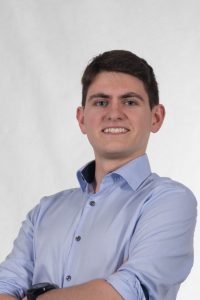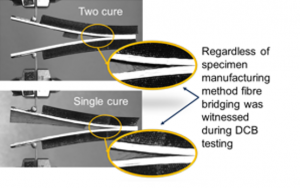We interviewed Bristol Composites Institute PhD student Michael O’Leary about his PhD project and the mutual benefits of working with Airbus on a cutting-edge research project.
How did you end up studying at the Bristol Composites Institute?

On leaving school, I realised I wanted to pursue a degree in Engineering, eventually specialising in Aeronautical Engineering and graduating with my bachelors from the University of Limerick. I had my final year project examined by Professor Paul Weaver, who recommended applying to the Bristol Composites Institute for PhD.
I decided that the Centre for Doctoral Training would be a great fit for me as I had enjoyed the research aspect of my final year. The collaborative environment of the CDT, being surrounded by people with similar research interests and skills, was a great selling point for me.
What are you working on?
My project is focused on integrated structures with semi-cured elements.
For future wing structure, we are moving towards more highly integrated and larger structures. As we make these integrated structures, we start to encounter some of the manufacturing challenges associated with the scale, such as element alignment and complexity.
The objective of my project is to break the integrated structure back down into smaller pieces and use them semi-cured as a building block to bring them back together. For instance, the state of the art for current structures manufacturing is using a skin, bonded stringers, and bolted ribs. Why not semi-cure each individual part and integrate them all together for a final cure?
How do you manufacture integrated structures with semi-cured elements?
The manufacturing process is a two-step curing process. The initial step is to create the semi-cured elements with a pre-designated degree of curing, somewhere between uncured and fully cured, hence the name. After the curing process, the semi-cured element can be stored, trimmed, and inspected. If they are of acceptable quality, they can then be integrated.
What are some of the manufacturing challenges when using semi-cured elements?
The main manufacturing challenges that we are facing are about determining the degree of curing and scaling, especially for more complex geometries as there are tooling requirements that can complicate the process.

What are the next steps for this work?
The next steps are to continue to determine the optimal degree of cure for semi-curing along with better understanding how semi-cured interfaces are forming. Outside of this, we will continue to prove the feasibility of semi-curing by starting to produce parts at a scale greater than coupon level.
How will the project results benefit the academic and industrial project partners?
Proving the feasibility of this work will provide the industry with an additional manufacturing tool that they can use when designing future structures. Hopefully, my work will lead to further questions which can be posed to incoming PhD candidates.
How has your cooperation with industrial partners supported the development of this project or your skills?
My primary industrial partner is Airbus. The industrial supervisors have been very helpful and supportive providing important technical knowledge and ideas which have made their way into my work. Having an industrial project gives a different perspective, it really helps me to see how my work can be applied in the real world.
Through this industrial project, I had the opportunity to interact with one of the world’s largest aerospace manufacturers. It has helped foster relationships which would not have been possible outside of this project.
